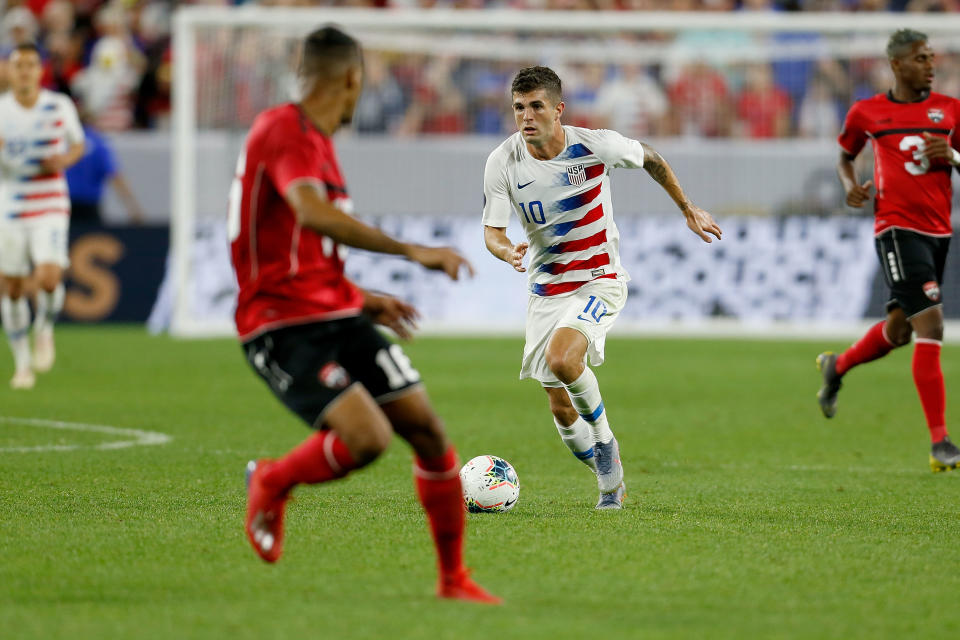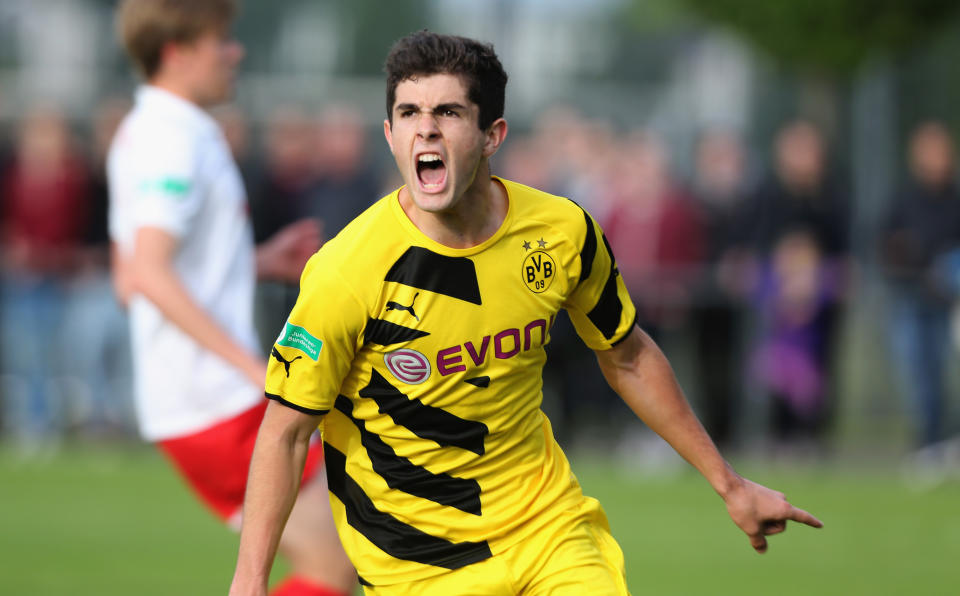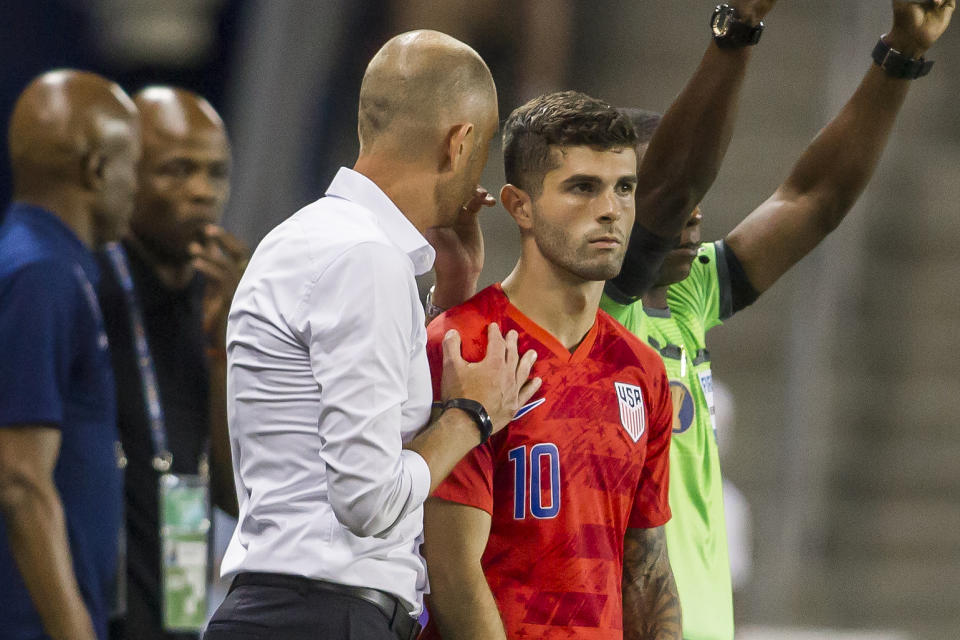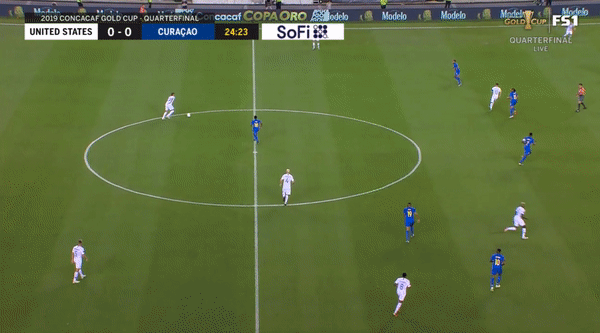Inside Christian Pulisic's positional evolution

PHILADELPHIA — The Christian Pulisic Story begins not far from here – two hours west on the Pennsylvania Turnpike, in quaint little Hershey. This story, however, begins elsewhere. In basements and offices, living rooms and bedrooms, coast to coast.
There, a few short years ago, soccer fans began tracking the Great American Hope. Diehards still remember the all-touch highlight reels. The amateurish streams. The match reports from unverified Twitter accounts. The fanatical blog posts.
They were integral tools for an American soccer community obsessed with the future. And they have framed a debate that has accompanied the first three years of Pulisic’s U.S. national team career. A behavioral scientist might call it anchoring. What is Pulisic’s best position? Well, he was a winger when he flickered onto most fans’ radars. He was a winger when he broke Bundesliga “youngest to” records, and a winger when he burst into Champions League 11s.
He was, therefore, a winger.
Period.
At least in fans’ eyes.
To play him elsewhere was to deviate from a quite successful norm.
Thus, as national team coach after national team coach tended to do just that, handing Pulisic a variety of central roles, public discussion surrounding the tendency was primed by an idea that it was unnatural. After the USMNT’s 2019 Gold Cup opener, a journalist suggested to Pulisic that he was “not playing in [his] typical position.”
Pulisic’s calm, hushed, perhaps slightly annoyed voice interjected.
And so will we, briefly, with a refresher. When Dortmund scouts first fell for Pulisic, he was starring for the U.S. under-17s. The coach of that team was Richie Williams. “For us,” Williams tells Yahoo Sports, “at the beginning, he might have played a little bit out wide. But very quickly, we realized his potential ... and we ended up putting him inside.”
So back to Pulisic. “I’ve played there a lot throughout my career,” he said two weeks ago as teammates filed out of Allianz Field. “I’ve played in the middle a lot. And I’m comfortable there.”
Which does not mean he’ll always be there. His role evolves, by the game, and even within one. “I can see also that he can play wide, because of his explosive pace, and his ability to get by someone,” Gregg Berhalter recently said.
“But I think he has versatility,” the USMNT boss continued. That versatility, rather than an anchored positional designation, should be the baseline for this discussion.
The source of Pulisic’s versatility
When Pulisic reports to Chelsea Football Club for preseason later this month, he’ll arrive ready to learn from his ninth manager in less than three calendar years.
At Dortmund, there was Thomas Tuchel, then Peter Bosz, then Peter Stoger, then Lucien Favre. With the USMNT, there was Jurgen Klinsmann, then Bruce Arena, then Dave Sarachan, and now Berhalter. At Chelsea, there was Maurizio Sarri, until there wasn’t. Frank Lampard will reportedly be Pulisic Coach No. 9 instead.
It’s a remarkable amount of upheaval for an under-21 player to endure.
“But I think it’s been really good for me,” Pulisic said Saturday when asked about the turnover. “I’ve learned a lot under different coaches. I’ve had different systems, I’ve seen different ideas ... To me, it’s only really helped.”
It’s also nothing new for a kid who grew up on the move. From 3-v-3 near Hershey to futsal in Detroit. From hardcourts in England to the plush green lawns of Barcelona’s famed La Masia in Spain. From U.S. Soccer’s development academy to its residency program to Dortmund’s under-19s, Pulisic had already been exposed to a wide variety of environments when he turned pro.

The diverse soccer upbringing diversified his understanding of the game. Pulisic also watched European footy throughout his youth. He played in pressure-free and unstructured settings.
When he did enter 11-v-11 battle, he played several positions. “He’d play as a 10, or as a wide player,” says Steve Klein, director of coaching for the PA Classics, Pulisic’s youth club. “Same thing with the [U-14 and U-15] national teams.”
So did the teenage versatility enable the pro versatility?
“I think it does help players to develop, at younger ages, where they’re exposed to different positions,” Williams says. “Because they see the game differently.”
But versatility, Klein says, is more so about building foundational skills – mental skills and physical ones, skills that young Christian acquired in abundance, in multiple cities on multiple continents.
“You develop qualities,” Klein says. “And the more qualities you have, the more versatile you are as a player. So it’s not because he played multiple positions ... when you train teams at younger ages, you don’t train kids in positions. ... Obviously, the more you play a position, you get more comfortable with it. But really, it comes down to what your skill set is.”
How Pulisic ‘interprets’ positions
Pulisic’s preeminent skill is defender-skinning. It’s one his father, Mark, a former professional player and later coach himself, always encouraged. It’s also one primarily associated with wing play. Its scarcity at elite levels sucked Pulisic out wide.
But it isn’t the 20-year-old’s only skill. Jurgen Klopp, Borussia Dortmund’s manager when Pulisic arrived, recognized as much in 2015. “In a very intense training session, with narrow spaces, he did not stand out in a negative way,” Klopp said at the time of a 16-year-old Christian. “This is a real sign of quality.”
Complementing the 1-v-1 ability are agility, devastating quickness and close control. Vision, spatial awareness, and, more broadly, technique. In a vacuum, all are precious.
But their exact value varies situationally, dependent on systems and positions, teammates and opponents, game states and so much more. A manager’s job is to maximize that value relative to replacements or alternatives. It’s a complex proposition, one Berhalter has studied “heavily.”

Many of the relevant variables, however, can’t be defined. Pulisic is still learning, growing, his full potential not yet realized. “What I think we’re trying to do is develop other skill sets in Christian, and bring other sides out of his game,” Berhalter said on Gold Cup eve.
For the moment, that means deploying him as a No. 10. But even that moniker, more so in modern football than ever before, is amorphous.
“When you watch Christian, he’s a player who plays on intuition a lot,” Berhalter continued. “So we put him in a different position, and we get to see how he interprets it. It’s really nice to see how he can open space, his movements to create space, his combination play in those positions.
“I think we’re used to seeing him getting the ball, isolating and going at players. So when we move him into these positions, we get to see how he interprets it.”
Pulisic’s evolving USMNT role
The interpretation can evolve, faintly or drastically, at any time. The evolution, in theory, leads to an equilibrium that optimizes Pulisic’s skill set.
That equilibrium is somewhere in between “winger” and “central playmaker.” It allows Pulisic to tap into talents commonly associated with each.
When the U.S. builds with the ball, for example, he can lurk in the half-space, or exchange with left winger Paul Arriola and drift toward the sideline.

He can also dart into higher wide areas – specifically, zones 13 and 16 – which purposeful movements from Arriola have vacated. When he does, positional designations disappear; Pulisic becomes the winger you once watched dice up German teens.

Some of the movements are choreographed. Others, as Pulisic said after a 6-0 rout of Trinidad and Tobago, are products of “read[ing] when is the right time to do it.”
And as Arriola explained that night: “I always tell Christian, it’s whatever he sees. As soon as he goes wide, my job is to come inside. If he stays inside, I’m going out wide. It’s very interchangeable.”
Pulisic, though, is also the USMNT’s biggest zone 14 threat. Speaking two weeks ago, Berhalter recalled a rep from that day’s training session, a “combination” he later discussed with Weston McKennie, “where the ball’s traveling really fast, one touch, in between lines, and [Pulisic is] on the end of it, and able to combine and get away from players.”
Then there’s Pulisic’s defensive position – something Berhalter confirms he considered when devising the role. It’s a similar consideration to the one Williams made when choosing to play Pulisic centrally with the 17s.
“We would defend in a 4-4-2,” Williams explains. Pulisic would step up alongside a lone striker to lead the press. “So even if they got beyond us, when the ball turned over, he was higher up the field. Whereas if he’s playing out wide, at times, you’re tracking back deeper, helping your right or left back, you might be defending in the defensive third of the field. The ball turns over, he still has a long way to go until he gets into the attack.”
The senior national team currently defends in a 4-4-2 as well. Crucially, defensive shape doubles as an attacking transition base. This is another phase where Pulisic excels. Playing him as a press-setting 10 turns him into a counter-attacking outlet, and allows him to hurt opponents on the break.

There will come a time, surely, when Pulisic reappears as a nominal winger in red, white and blue. There will come a time, hopefully, when alternatives arise centrally. Or a time when gameplans require a threat out wide.
For now, though, Pulisic is at home in the middle. He does not find it difficult to recalibrate his soccer brain when he arrives at national team camp. After all, change and deserted comfort zones have become customary – so customary that comfort quickly returns.
“The team likes to put me in a position where I can affect the game, I can make the runs that I do,” Pulisic said Saturday. “And yeah, I’m very comfortable.”
– – – – – – –
Henry Bushnell is a features writer for Yahoo Sports. Have a tip? Question? Comment? Email him at henrydbushnell@gmail.com, or follow him on Twitter @HenryBushnell, and on Facebook.
More from Yahoo Sports:

 Yahoo Sport
Yahoo Sport 






































